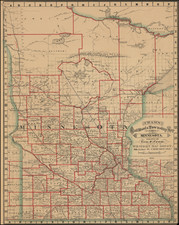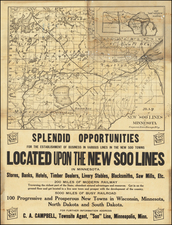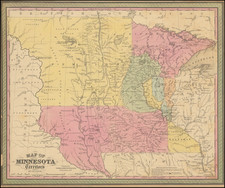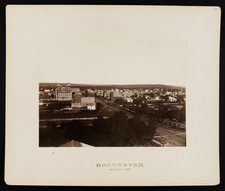The First Edifice of Local Government in Minnesota.
Important photograph of Ramsey County's first courthouse, taken a few years after its completion in 1851.
The construction of the courthouse lasted from 1850 to August 1851. It was built on the square bounded by Fourth and Fifth, and Wabasha and Cedar Streets.
A manuscript annotation below the printed caption reads "Torn down to give place to the new Court House".
Dane Smith's 1993 article "A Short and Happy History of Ramsey County and Its Two Earlier Courthouses" notes that the land for the courthouse was donated by Vetal Guerin, one of St. Paul's earliest settlers. At the time the courthouse was built it was perhaps the first permanent administrative structure in Minnesota. In its earliest configuration, Ramsey County covered a much larger portion of the state than it does today.
The courthouse was designed by pioneer physician Dr. David Day.
According to a flyer distributed in 1932, the original courthouse "was the pride of the city, all important meetings and many theatrical performances being held there."
When the 1851 courthouse was razed, the Saint Paul Pioneer Press added up the legal activities that had taken place there over thirty-five years and found that they included 40,295 criminal cases, 475,000 records filed for real estate, and 35,000 marriage license applications.
Provenance
Deaccessioned from the James J. Hill Reference Library, St. Paul, Minnesota.
Such early Minnesota photographs are rare and almost unobtainable outside institutional deaccessions.
Edward A. Bromley (September 24, 1848 - June 21, 1925) was a native of New Haven, Connecticut, who arrived in Minnesota with his parents in 1867. Bromely was a reporter and photographer for the St. Paul Pioneer Press and was a true collector and historian at heart. He began collecting coins but quickly transitioned into early photography, particularly original matrixes made in Minnesota from 1849 onward.
Bromley's first purchase of negatives was from Benjamin F. Upton of St. Anthony, from whom he purchased over 500 negatives in 1878 when Upton relocated to Florida.
He then purchased 1600 negatives of landscape views and related scenes from William H. Illingworth's gallery in St. Paul.
Over the course of his first ten years of collecting, Bromley purchased the negatives and plates of 30 other local photographers (including Pepper, Jacoby, Rugg, and Harvey) altogether increasing the collection to about 7000 original matrixes.
Bromley was a photographer himself, and in addition to the work he did for the newspapers he worked for, he photographed Minnesota Indian tribes and important local figures.
Bromley sold a portion of his collection to the Minneapolis Public Library in 1914. Bromley published several books that were illustrated by prints from his collection.
Bromley's preface to his 1890 Minneapolis Album is instructive for understanding his motivation and process for acquiring and publishing historical photographs of Minnesota. While the text refers specifically to Minneapolis, the thoughts apply to all of his published work, including the photographs he published of St. Paul:
In offering this volume to the public derive especial satisfaction, from the fact that it is unlike any other ever published. Its originality consists in the fact that although it comprises the earliest history of the city, the plates, with one exception, are all sun pictures. When I began, fourteen years ago, to collect material for this work, my aim was to secure views of old St. Anthony and Minneapolis that had been made by chemical processes in the sunlight, and so working back to first principles, I purchased several rare daguerreotypes, and then two that had been made by Daguerre's process on leather. These I supplemented with several ambrotypes, and subsequently was fortunate in securing the first glass negatives made in the Northwest, they being the handiwork of those veteran photographers, B. F. Upton and J. E. Whitney, and dating back to 1857. When this point had been reached I was in possession of material that presented in a picturesque and attractive form the history of Minneapolis from the log cabin period of the Steele, Pond, Bottineau, and Russell epoch to the days of the suspension bridge, the court house, the saw mills, and the Winslow and Nicollet hotels. At this point, although still drawing material from, the negatives of the gentlemen above referred to, I was enabled, through the kindness of A. H. Beal and W. H. Jacoby, to enrich my collection with negatives taken by them at intervals between 1860 and 1880, thereby rounding out the work which I had begun with scanty material. Several instances will be noticed in which pictures have been introduced that are not of a purely local character. They were inserted because the citizens of St. Anthony and Minneapolis were either active participants in the events so pictured, as in the case of the Indian outbreak, and the massing of troops at Fort Snelling for the civil war, or were otherwise especially interested in the scenes depicted. The descriptions accompanying the plates were written after diligent search among the files of old newspapers, rigid cross-examination of old settlers, and occasional delving into musty volumes that recorded the deeds of the worthy pioneers of this great city. It is my hope that all the readers of this book may derive pleasure from its perusal, and that it will awaken in the minds of the old settlers many enjoyable reminiscences.
MINNEAPOLIS, September 10, 1890.
EDWARD A. BROMLEY.
See the Hennepin County Library Digital Collections record for Edward A. Bromley.









![[ Great Lakes - Upper Midwest -- Western Canada ] Partie Occidentale Du Canada, contenant les cinq Grands Lacs, avec Pays Circonvoisons](https://storage.googleapis.com/raremaps/img/small/98377.jpg)



![[ Map of the Mississippi River ]](https://storage.googleapis.com/raremaps/img/small/99811.jpg)
